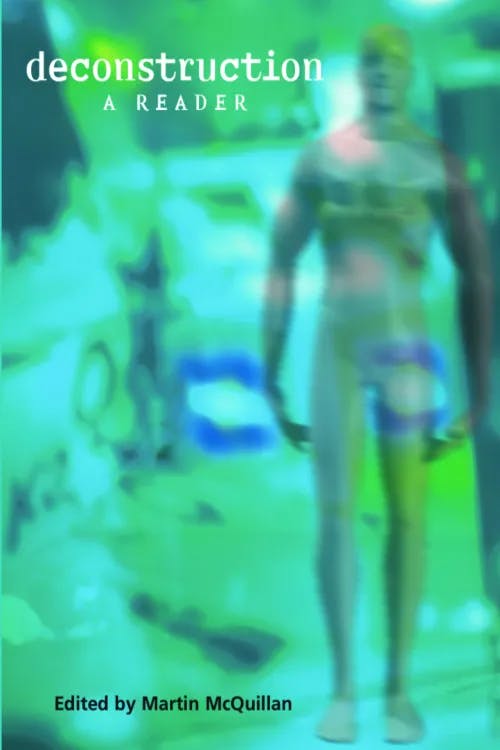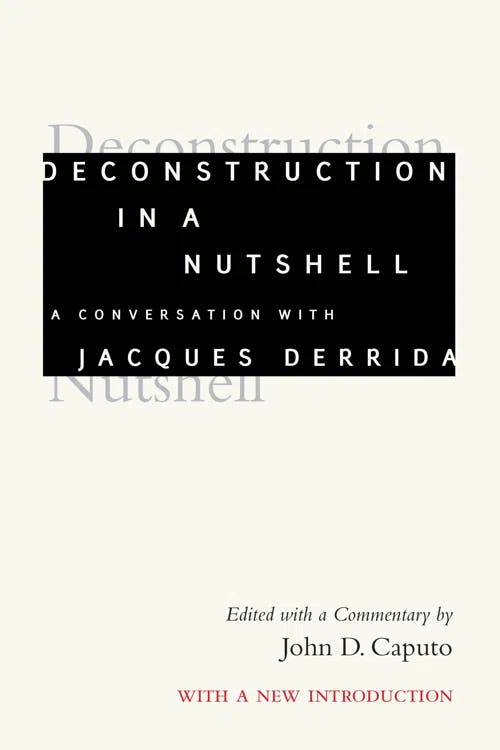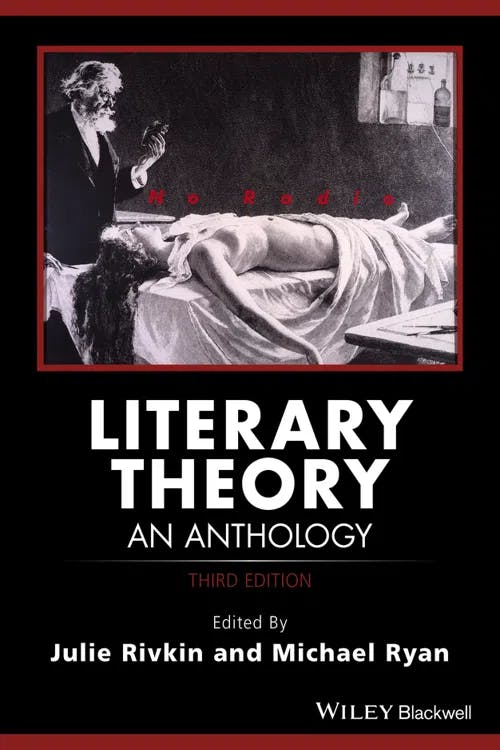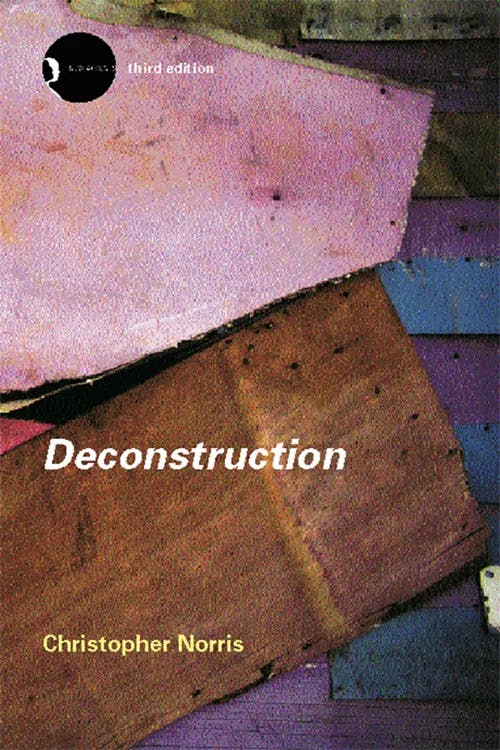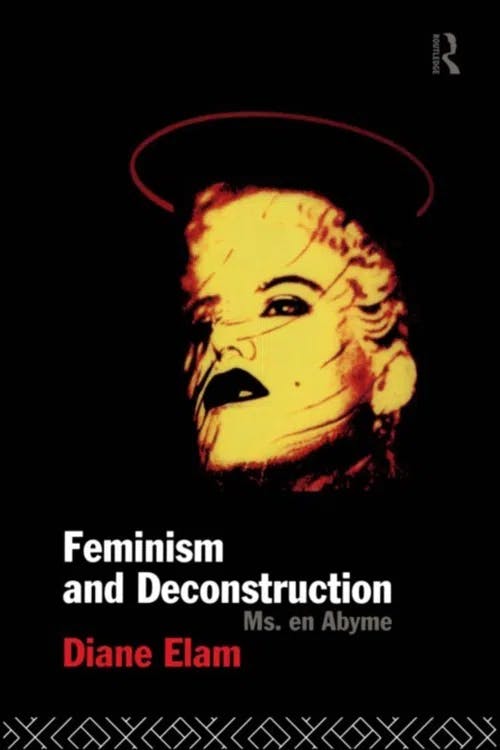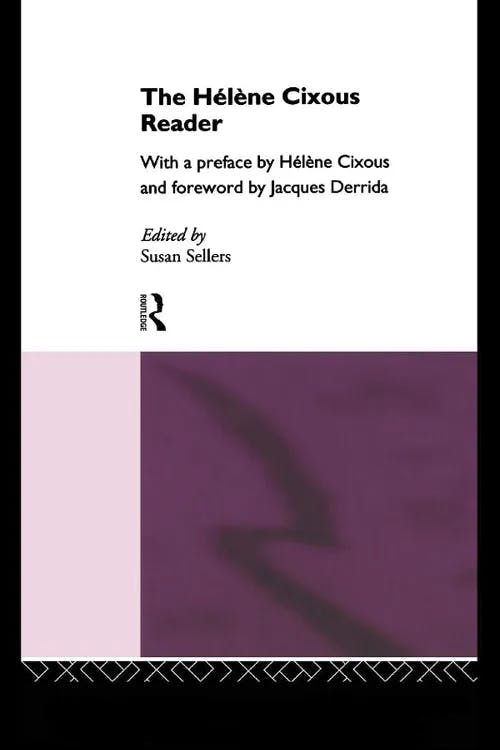What is Deconstruction?
MSt, Women's, Gender & Sexuality Studies (University of Oxford)
Date Published: 06.09.2023,
Last Updated: 24.01.2024
Share this article
Defining deconstruction
Providing a succinct definition of deconstruction is a difficult if not impossible task. Jacques Derrida (1930–2004), the “founder” of deconstruction himself, struggled to describe deconstruction “in a nutshell” (Derrida, Points…, 1995). Martin McQuillan writes,
Any attempt to define [deconstruction] will fail, or at least come undone, because all the defining concepts and means of articulation and signification are themselves open to the effects of this thing. This includes the term itself. (2001)
Martin McQuillan
Any attempt to define [deconstruction] will fail, or at least come undone, because all the defining concepts and means of articulation and signification are themselves open to the effects of this thing. This includes the term itself. (2001)
But let us embrace this failure, as deconstruction requires us to, for the sake of starting somewhere.
Deconstruction is an act of reading that unsettles assumptions and stable meanings by locating paradoxes within structures (especially texts) that undermine the very systems they work to construct. In Deconstruction in a Nutshell (2020), John D. Caputo writes,
The very meaning and mission of deconstruction is to show that things—texts, institutions, traditions, societies, beliefs, and practices of whatever size and sort you need—do not have definable meanings and determinable missions, that they are always more than any mission would impose, that they exceed the boundaries they currently occupy.
Jacques Derrida and John D. Caputo
The very meaning and mission of deconstruction is to show that things—texts, institutions, traditions, societies, beliefs, and practices of whatever size and sort you need—do not have definable meanings and determinable missions, that they are always more than any mission would impose, that they exceed the boundaries they currently occupy.
Deconstruction argues that things are always more complicated than a neat definition would allow and are always extending beyond the boundaries we construct for them.
Deconstruction is defined by its undefinability. Deconstruction has been used — and misused — to indicate a philosophical position or school, a method of reading, an intellectual and political approach, a theory of literary criticism, what Derrida does, what Derrida’s “followers” do, the unifying “ideology” of Derrida’s body of work, and a “radical” (even threatening) strain of postmodern critical theory.
Deconstruction eschews missions, dogmas, and structures; it is not a unified school of philosophy nor a clear methodology. In the 1994 roundtable Caputo transcribed, Derrida emphasizes that deconstruction is “not a method or some tool that you apply to something from the outside” but rather a process “which happens inside” (2020).
In other words, deconstruction is a textual event, an act of reading that notices what is already occurring within the text. Rooting deconstruction in the text is essential: Derrida’s approach is an explicitly textual one, and he aims to show the textual nature of our world. The textual roots of deconstruction make it appealing to scholars of literary studies, but deconstruction can and does occur within other fields including philosophy, theology, politics, and architecture.
When first introduced, deconstruction sparked debate and outrage in academic circles and the public media. Decried as the “end of philosophy,” deconstruction was associated with “a destructive attitude toward texts and traditions and truth” and constructed as “the enemy of academic programs and academic institutions” (Caputo, in Derrida and Caputo, 2020). But, as Derrida explains, deconstruction does not reject the so-called Western canon wholesale: “respect for the great texts [...] is the condition of our work” (2020). Derrida clarifies that his method of reading Plato, Aristotle, and other “canonical” writers is not “ a way of commanding, repeating, or conserving this heritage” (2020). Instead,
To better understand how deconstruction works, let’s examine its origins before unpacking some key concepts and applications.
Origins of deconstruction
The 1950s and 1960s were a fruitful time for French philosophy. Influential figures like Maurice Merleau-Ponty, Jean-Paul Sartre, Simone de Beauvoir, Claude Lévi-Strauss, and Jacques Lacan were still alive, and a new generation including Gilles Deleuze, Michel Foucault, Louis Althusser, Jean-François Lyotard, and Roland Barthes was coming of age. During this period, structuralism rose to particular prominence.
Structuralism is an intellectual movement that aims to identify and describe fixed systems shaping language, culture, literature, and more. Structuralists drew heavily on Ferdinand de Saussure’s Course in General Linguistics (1916), which described semiology/semiotics, or the study of sign systems. In brief, a sign consists of a signifier (the sound-image) and a signified (its referent). For example, the letters T-R-E-E and sound they produce when spoken signify a large plant with roots, a trunk, branches, and foliage. The word “tree” is the signifier; the concept of a tree is the signified.
For Saussure, the relationship between signifier and signified is arbitrary. There is no natural reason “tree” should mean tree (hence why different languages have different words for the same thing). However, Saussure and structuralists after him believed that, although arbitrary, the sign’s meaning is fixed. La parole (the word, the speech action) fits into a larger system, la langue (the language, the governing system of rules).
Structuralism applies Saussure’s ideas to all human-created systems. For example, prominent structuralist Lévi-Strauss founded structural anthropology, proposing that all human cultures must share underlying similarities. In “The Structural Study of Myth” (1955), reprinted in Literary Theory (2017), Lévi-Strauss argues that analyzing different versions of myths can reveal concerns regarding universally-recognized contradictions like culture/nature, good/evil, masculine/feminine, and human/supernatural.
Derrida’s writings on deconstruction emerged at the forefront of a scholarly movement to use and reimagine structuralist ideas in order to destabilize fixed meanings. Born in Algeria, then a French colony, to a Sephardic Jewish family, Derrida drew upon his life in many of his writings. In 1952, he gained admittance to the prestigious École Normale Supérieure, where he studied Husserl, Hegel, and phenomenology. Derrida introduced deconstruction at the influential 1966 conference “The Languages of Criticism and the Sciences of Man” and in three groundbreaking texts published in 1967: Writing and Difference, Voice and Phenomenon, and Of Grammatology (essential excerpts of all three are available in Jacques Derrida: Basic Writings [2020]).
Deconstruction is often associated with poststructuralism. Poststructuralism is both an extension and critique of structuralism; it challenges an understanding of signs as fixed, proposing instead that meanings are constantly shifting and that signifiers can point to other signifiers instead of a stable signified. While deconstruction shares this basic interest, poststructuralism is an umbrella term for a wide range of scholarship after structuralism, so the terms should not be conflated. Deconstruction has also been considered a product of postmodernism, but Derrida resisted this periodization. According to him, deconstruction already happens in texts from any period, so it should not be understood as a strictly postmodernist development.
Now let’s turn to some of deconstruction’s major ideas: logocentrism and différance.
Logocentrism and binary oppositions
Structuralists, especially Lévi-Strauss, viewed binary oppositions as core to cultural systems and beliefs. Derrida argues that “Western” traditions and cultures are, in fact, built on these binaries, but they are not equal opposites. Instead, they are hierarchies in which one term is privileged over the other. Take, for example, these binaries: west/east, masculine/feminine, culture/nature, familiar/exotic, scientific/mystical, logical/emotional. In Western culture and traditions, the first term in the binary is privileged over the second.
Derrida calls this system of unequal binaries “logocentrism.” This term comes from the Greek work “logos,” meaning “word.” In Western tradition, logos (speech, meaning, sense) is valued over pathos (emotions, feelings, nonsense). Logocentrism describes the system in which the first side of the binary is constructed as more valuable than the other side. The term “phallogocentrism” acknowledges how patriarchy (phallocentrism) is woven into this system, privileging male “presence” over female “absence.”
Derrida takes particular interest in how speaking is valued over writing and, relatedly, how signified is valued over signifier. He traces a history in Western thought in which writing is viewed as a mediator, an insufficient and even manipulative tool for expression. Similarly, the signifier is treated as merely metaphorical, “technical and representative”: it is necessary for communication but, unlike the signified, it has “no constitutive meaning” itself (“Of Grammatology: ‘Exergue’ and ‘The end of the book and the beginning of writing,’” Jacques Derrida, 2020).
Logocentrism pervades our society; it is ingrained in societal structures, languages, and cultures. These unequal binaries do not reflect reality but instead, Derrida argues, construct the identity of the privileged term (Man, the West, etc.) through the devaluation of the other term (Woman, the East, etc.). By continually repeating these inequalities in discourse (literary, philosophical, etc.), logocentrism works to appear “inherent” and unreadable. As McQuillan summarizes,
Logocentrism is the mode of thought which works through the erasure of the metaphorical status of privileged terms within a binary opposition in order to support a conceptual order structured around the valuing of such terms as positive. Thus logocentrism constructs, or centres, sense and meaning around the identity of these terms, while disguising the unresolvable tensions within them. (2001)
Martin McQuillan
Logocentrism is the mode of thought which works through the erasure of the metaphorical status of privileged terms within a binary opposition in order to support a conceptual order structured around the valuing of such terms as positive. Thus logocentrism constructs, or centres, sense and meaning around the identity of these terms, while disguising the unresolvable tensions within them. (2001)
By exploring those unresolvable tensions, deconstruction aims to identify and undo logocentrism. This process involves two steps. First, the binary is reversed. After revealing the binary, one must demonstrate that there is no justification for devalorizing one of the terms outside of logocentrism’s own logic. This proves the binary to be a false opposition. But one cannot stop here and simply reproduce the binary logic by switching the terms. Second, the system of binary thinking is displaced altogether. This is deconstruction.
This is, of course, impossible. Logocentrism is pervasive. Even envisioning an alternative to logocentrism must begin with logocentric thought. An alternate way is impossible to reach without subsuming it into logocentric thinking.
However, we must not abandon hope. While working to dissolve logocentrism, deconstruction embraces multiplicity and hybridity. Derrida sees the center and the boundary as necessarily entwined; nothing is pure or unified:
For Derrida, hybridity and difference are a political and ethical necessity. He does not wish to locate himself at either end of a strict binary: “pure unity or pure multiplicity—when there is only totality or unity and when there is only multiplicity or disassociation—is a synonym of death” (2020). Instead, Derrida is interested in “the limit of every attempt to totalize, to gather” (2020).
Derrida’s embrace of hybridity and difference leads to another key idea in deconstruction: différance.
Différance
Essential to logocentrism’s binaries and to Saussure’s linguistics is difference. “Différance” deconstructs difference. Saussure’s semiotics relies on difference: the signifier “tree” only indicates the signified tree because it is not “free” or “terrier” or “Toronto.” Conversely, Derrida’s différance is intended to reveal how difference is impossible. While logocentric binaries construct identity through difference, différance calls attention to these systems, reveals how they are constructed, and treats their borders as interminable rather than fixed.
To write différance, Derrida changes on letter in the French différence (difference). This change cannot be pronounced; it is only legible through writing — an intentional choice by Derrida as he strives to combat logocentrism’s devaluation of writing. Différance plays on the French verb différer which can mean both “to differ” and “to defer.” It “involves an action of time (deferral) and action of space (differing),” resisting the philosophical binary between time and space (McQuillan, 2001). The meaning of “deferral” also endows différance with a passivity. Derrida writes,
Differance is not simply active (any more than it is a subjective accomplishment); it rather indicates the middle voice, it precedes and sets up the opposition between passivity and activity. With its a, differance more properly refers to what in classical language would be called the origin or production of differences and the differences between differences, the play [jeu] of differences. (Derrida, “Différance,” in Literary Theory, 2017)
Edited by Julie Rivkin and Michael Ryan
Differance is not simply active (any more than it is a subjective accomplishment); it rather indicates the middle voice, it precedes and sets up the opposition between passivity and activity. With its a, differance more properly refers to what in classical language would be called the origin or production of differences and the differences between differences, the play [jeu] of differences. (Derrida, “Différance,” in Literary Theory, 2017)
Christopher Norris notes that the term’s many valences reflect Derrida’s project. Norris writes that différance “sets up a disturbance at the level of the signifier” through its unpronounceable change in spelling and double meaning:
Language depends on ‘difference’ since, as Saussure showed once and for all, it consists in the structure of distinctive oppositions which make up its basic economy. Where Derrida breaks new ground, and where the science of grammatology takes its cue, is in the extent to which ‘differ’ shades into ‘defer’. This involves the idea that meaning is always deferred, perhaps to the point of an endless supplementarity, by the play of signification. Différance not only designates this theme but offers in its own unstable meaning a graphic example of the process at work. (2003)
Christopher Norris
Language depends on ‘difference’ since, as Saussure showed once and for all, it consists in the structure of distinctive oppositions which make up its basic economy. Where Derrida breaks new ground, and where the science of grammatology takes its cue, is in the extent to which ‘differ’ shades into ‘defer’. This involves the idea that meaning is always deferred, perhaps to the point of an endless supplementarity, by the play of signification. Différance not only designates this theme but offers in its own unstable meaning a graphic example of the process at work. (2003)
Rather than naming the difference between “tree” and “Toronto,” Derrida’s différance describes how systems have been constructed through difference and how, still, signifiers often relate to other signifiers, rather than clear signifieds. McQuillan writes,
With an understanding of logocentrism and différance, let us look at how deconstruction works in several disciplinary contexts.
Deconstruction and literary studies
Given Derrida’s attention to writing and texts, it is unsurprising that deconstruction has influenced literary studies. Derrida encouraged philosophers to recognize the literary nature of all texts, including their own.
Deconstruction approaches each text as a singularity, speaking uniquely to this reader. Because deconstruction happens within the text, the reader should not arrive with expected interpretations (as other methodologies might provoke). Instead, within the text, deconstruction locates the construction of the text’s logic and paradoxes undermining that logic. From this close reading, one can draw connections between the text and larger systems glimpsed within it.
Derrida’s line “there is nothing outside of the text” is often taken out of context to accuse deconstruction of reading texts in isolation (Of Grammatology, 1967, [2016]). However, this is not what Derrida means. Conversely, Derrida argues that history, politics, economics — context in general — is not outside of the text but rather inscribed within it. In other words, “when reading a text there is nothing but context” (McQuillan, 2001). In fact, these contexts are textual themselves: a political context like colonialism depends on “laws, charters, policy statements, acts of parliament, slogans, propaganda, popular literature” and more (McQuillan, 2001). Rather than isolating the text or imposing a methodology, we are encouraged to see context within the text, allowing our reading to stretch beyond the text by reading it more closely.
For deconstruction in action, see McQuillan’s reading of Jane Eyre (1847) in the introduction to Deconstruction: A Reader.
The Yale school
The “Yale school” was a group of influential literary scholars who popularized deconstruction in America. Paul de Man is the most famous of the Yale school, but other associated figures include Geoffrey Hartman, J. Hillis Miller, Shoshana Feldman, and Harold Bloom.
The Yale school’s approach to deconstruction is distinct from Derrida’s original ideas. De Man in particular was skeptical of political action and believed that “the problems of language (reading) had made it impossible to attend to the questions of history” (Srinivasan, “de Man, Paul,” A Dictionary of Cultural and Critical Theory, 2013). De Man did treat the text in isolation, striving to read it “literally” and find meaning in its rhetoric alone, without need of theory or context. While De Man’s work shares Derrida’s desire to unsettle binary distinctions and singular interpretations, he and the Yale school have been criticized for being overly erudite and avoiding philosophical or political conclusions. For more on de Man, see Paul de Man (2009) by Christopher Norris and Paul de Man (2001) by Martin McQuillan as well as Paul de Man’s influential Blindness and Insight (1971, [2013]).
While members of the Yale school may take a more formalist approach to deconstruction, closed off to context and interdisciplinarity, McQuillan writes,
Deconstruction and feminism
Deconstruction and feminism may not seem to have much in common. As Diane Elam writes in Feminism and Deconstruction (1994, [2006]), “[f]eminism seems to be a political project, whereas deconstruction appears more philosophical or literary. By this account, their mutual interests do not converge.” However, Elam explores how feminism and deconstruction “share a parallel divergence from (or dislocation of) politics and philosophy”:
On the one hand, feminism shifts the ground of the political, interrogating the opposition between the public and the private spheres. On the other hand, deconstruction displaces our understanding of how theory relates to practice by rethinking the opposition of philosophical reflection to political action. (1994, [2006])
Diane Elam
On the one hand, feminism shifts the ground of the political, interrogating the opposition between the public and the private spheres. On the other hand, deconstruction displaces our understanding of how theory relates to practice by rethinking the opposition of philosophical reflection to political action. (1994, [2006])
Several scholars have productively worked across feminism and deconstruction. Judith Butler deconstructs sex and gender in Gender Trouble (1990) and Bodies That Matter (1996), elucidating paradoxes within the systems that construct gender and sex as stable and fixed (see our study guide to Butler’s theory of gender performativity for more).
One founder of poststructuralist feminism is Hélène Cixous who frequently collaborated with and wrote about Derrida. Cixous theorized a form of “feminine writing” (écriture féminine) that could avoid reproducing existing structures. Deconstruction aims to listen to the “other,” the voice at the margins of the text. Yet, because of logocentrism’s power, Derrida’s deconstruction understands that listening to the “other” requires it to be subsumed into the dominant system to some extent in order for it to be understood. However, as Susan Sellers summarizes, Cixous argued that “a feminine subject position refuses to appropriate or annihilate the other’s difference in order to construct the self in a (masculine) position of mastery” (The Hélène Cixous Reader, 2003). Sellers continues,
feminine writing will bring into existence alternative forms of relation, perception and expression. [...] Not only can writing exceed the binary logic that informs our present system and thus create the framework for a new “language” and culture, but [...] feminine writing will initiate changes in the social and political sphere to challenge the very foundation of the patriarchal and capitalist state. (2003)
Edited by Susan Sellers
feminine writing will bring into existence alternative forms of relation, perception and expression. [...] Not only can writing exceed the binary logic that informs our present system and thus create the framework for a new “language” and culture, but [...] feminine writing will initiate changes in the social and political sphere to challenge the very foundation of the patriarchal and capitalist state. (2003)
This possibility makes feminine writing revolutionary. While feminism and deconstruction do not work perfectly together, they can produce rich scholarship with political import. As Elam argues,
For more on feminism and deconstruction, see Penelope Deutscher’s Yielding Gender (1997), Leticia Glocer Fiorini’s Deconstructing the Feminine (2009), Lynn Turner’s Poetics of Deconstruction (2020), and The Deconstruction of Sex (2021) by Jean-Luc Nancy and Irving Goh.
Deconstruction beyond Derrida
Essential elements of deconstruction — identifying contradictions, trusting that there is no singular interpretation, treating binaries not as not inherent but as constructed hierarchies — have become accepted practice within critical theory.
Deconstruction reaches far beyond literary theory and philosophy. Restaurants serve “deconstructed” dishes with elements separated rather than unified. Architecture underwent a “deconstructivism” movement that rejected rules of classical architecture and embraced fragmentation and asymmetry, and books like Deconstructing the High Line (2017) treat deconstruction as a tool within an interdisciplinary approach to architecture and urban studies. Scholars like Caputo have always been interested in applying deconstruction to theology, and in the twenty-first century, the “faith deconstruction” movement has gained traction: Christians who are “deconstructing” interrogate their beliefs and dissect traditional teachings, sometimes to the point of no longer identifying as Christian. Any topic seems open for deconstructing, from dolls to Disney to developmental psychology to the death penalty (addressed by Derrida himself).
Deconstruction has been accepted into critical parlance, almost to the point of losing its meaning. Books featuring “deconstructing” in their titles may not even reference deconstruction or Derrida at all, and sometimes “deconstructing” seems to be a synonym for “examining closely” or “dissecting.” While for years Derrida was synonymous with deconstruction, it is clear that deconstruction is moving beyond Derrida’s initial interpretations. Derrida’s own writing is subject to deconstruction: what new paradoxes and meanings might we find there?
As McQuillan writes, “Deconstruction, if it teaches anything, reminds us that we should not assume that the way we perceive the world is the same as the way the world actually is” (2001). Deconstruction’s skepticism toward sharp distinctions and stable meanings, its distrust of assumptions, and its willingness to continue asking questions provide inspiration to scholars in any field.
Further reading on Perlego
On Deconstruction: Theory and Criticism after Structuralism (1988, [2014]) by Jonathan Culler
Against Deconstruction (1989, [2018]) by John Martin Ellis
The Politics of Deconstruction: Jacques Derrida and the Other of Philosophy (2007) edited by Martin McQuillan
Reading Derrida's Of Grammatology (2011) edited by Sean Gaston, Ian Maclachlan
The Invention of Deconstruction (2013) by Mark Curie
Politics of Deconstruction: A New Introduction to Jacques Derrida (2014) by Susanne Lüdemann
The Ethics of Deconstruction: Derrida and Levinas (1992, [2014]) by Simon Critchley
What is deconstruction in simple terms?
Who is the founder of deconstruction?
What are the best books on deconstruction?
Bibliography
Burman, E. (2016) Deconstructing Developmental Psychology. 3rd edn. Routledge. Available at: https://www.perlego.com/book/2192904/deconstructing-developmental-psychology-pdf
Butler, Judith. (2011) Gender Trouble: Feminism and the Subversion of Identity. Routledge. Available at: https://www.perlego.com/book/1607112/gender-trouble-feminism-and-the-subversion-of-identity-pdf
Butler, Judith. (2011) Bodies That Matter: On the Discursive Limits of Sex. Routledge. Available at: https://www.perlego.com/book/1607604/bodies-that-matter-on-the-discursive-limits-of-sex-pdf
Byrne, E. and McQuillan, M. (1999) Deconstructing Disney. Pluto Press. Available at: https://www.perlego.com/book/665026/deconstructing-disney-pdf
Derrida, J. (1995) Points…: Interviews, 1974–1994. Stanford University Press.
Derrida, J. (2010) Voice and Phenomenon: Introduction to the Problem of the Sign in Husserl's Phenomenology. Translated by L. Lawlor. Northwestern University Press.
Derrida, J. (2016) Of Grammatology. Translated by G. C. Spivak. Johns Hopkins University Press.
Derrida, J. (2017) “Différance,” in Rivkin, J. and Ryan, M. (ed.) Literary Theory: An Anthology. 3rd edn. Wiley. Available at: https://www.perlego.com/book/992490/literary-theory-an-anthology-pdf
Derrida, J. (2017) Writing and Difference. Translated by A. Bass. The University of Chicago Press.
Derrida, J. and Caputo, J. D. (2020) Deconstruction in a Nutshell: A Conversation with Jacques Derrida. Fordham University Press. Available at: https://www.perlego.com/book/1707800/deconstruction-in-a-nutshell-a-conversation-with-jacques-derrida-with-a-new-introduction-pdf
Deutscher, P. (2002) Yielding Gender: Feminism, Deconstruction and the History of Philosophy. Routledge. Available at: https://www.perlego.com/book/1625562/yielding-gender-feminism-deconstruction-and-the-history-of-philosophy-pdf
Elam, D. (2006) Feminism and Deconstruction. Routledge. Available at: https://www.perlego.com/book/1613629/feminism-and-deconstruction-pdf
Fiorini, L. G. (2018) Deconstructing the Feminine: Psychoanalysis, Gender and Theories of Complexity. Routledge. Available at: https://www.perlego.com/book/1505662/deconstructing-the-feminine-psychoanalysis-gender-and-theories-of-complexity-pdf
Forman-Brunell, M. (2021) Deconstructing Dolls: Girlhoods and the Meanings of Play. Berghahn Books. Available at: https://www.perlego.com/book/2604445/deconstructing-dolls-girlhoods-and-the-meanings-of-play-pdf
Lindner, C. and Rosa, B. (eds.) (2017) Deconstructing the High Line: Postindustrial Urbanism and the Rise of the Elevated Park. Rutgers University Press. Available at: https://www.perlego.com/book/400577/deconstructing-the-high-line-pdf
Macksey, R. and Donato, E. (eds.) (2007) The Structuralist Controversy: The Languages of Criticism and the Sciences of Man. Johns Hopkins University Press.
Man, P. (2013) Blindness and Insight: Essays in the Rhetoric of Contemporary Criticism. 2nd edn. Routledge. Available at: https://www.perlego.com/book/2192438/blindness-and-insight-essays-in-the-rhetoric-of-contemporary-criticism-pdf
McQuillan, M. (ed.) (2001) Deconstruction: A Reader. Edinburgh University Press. Available at: https://www.perlego.com/book/1708339/deconstruction-a-reader-pdf
McQuillian, M. (2001) Paul de Man. Routledge. Available at: https://www.perlego.com/book/1618913/paul-de-man-pdf
Norris, C. (2003) Deconstruction: Theory and Practice. 3rd edn. Routledge. Available at: https://www.perlego.com/book/1613869/deconstruction-theory-and-practice-pdf
Norris, C. (2009) Paul de Man: Deconstruction and the critique of aesthetic ideology. Routledge. Available at: https://www.perlego.com/book/1695676/paul-de-man-routledge-revivals-deconstruction-and-the-critique-of-aesthetic-ideology-pdf
Oliver, K. and Straub, S. (eds.) (2018) Deconstructing the Death Penalty: Derrida’s Seminars and the New Abolitionism. Fordham University Press. Available at: https://www.perlego.com/book/723112/deconstructing-the-death-penalty-derridas-seminars-and-the-new-abolitionism-pdf
Sellers, S. (ed.) (2003) The Hélène Cixous Reader. Routledge. Available at: https://www.perlego.com/book/1618443/the-hlne-cixous-reader-pdf
Srinivasan, S. K. (2013) “de Man, Paul,” in Payne, M. and Barbera, J. R. (eds.) A Dictionary of Cultural and Critical Theory. 2nd edn. Wiley. Available at: https://www.perlego.com/book/1002875/a-dictionary-of-cultural-and-critical-theory-pdf
Saussure, F. (2011) Course in General Linguistics. Translated by W. Baskin. Columbia University Press. Available at: https://www.perlego.com/book/774968/course-in-general-linguistics-pdf
Stocker, B. (ed.) (2020) Jacques Derrida: Basic Writings. Routledge. Available at: https://www.perlego.com/book/1974518/jacques-derrida-basic-writings-pdf
Turner, L. (2020) Poetics of Deconstruction: On the Threshold of Differences. Bloomsbury Publishing. Available at: https://www.perlego.com/book/1703622/poetics-of-deconstruction-on-the-threshold-of-differences-pdf
MSt, Women's, Gender & Sexuality Studies (University of Oxford)
Paige Elizabeth Allen has a Master’s degree in Women’s, Gender, and Sexuality Studies from the University of Oxford and a Bachelor’s degree in English from Princeton University. Her research interests include monstrosity, the Gothic tradition, illness in literature and culture, and musical theatre. Her dissertation examined sentient haunted houses through the lenses of posthumanism and queer theory.

